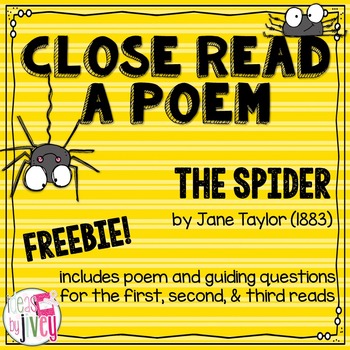Poetry is not just for April! Don’t save all the awesome poems for the spring! Everything you are doing with close reading can be done with a poem, too. Students can still infer, determine theme, compare characters or events, understand figurative language and word choice, explain how stanzas build on each other, determine mood or point of view, and compare poems to each other, just like they can with literature.
In this post, I will walk you through how I close read poetry with students.

I have used different colors for each step, but this is not necessary. (Although it IS prettier!)
When close reading a poem with students, before we read, I like students to label stanzas, verses, and sometimes even rhyme scheme.
Then in the first read, I just want students to “get the gist” of the poem. Students will annotate their initial thoughts during the first read. (Check this post for a great annotation bookmark students can use as a reminder!)
Sometimes I read it aloud to them during the first read, sometimes I want them to read it alone. It depends on how much I anticipate that they might struggle with it (I don’t want them to struggle TOO much, but a little is good). With this poem, I’d say most students 4th grade and up could read it alone.
During the second read, I always read the poem aloud to them. I will usually do some think-alouds along the way and ask questions about parts that I want them to really think about. I also talk about any cloudy words to make sure they understand the meaning (by leading them through context clues if possible). This is when students really dig in deep and try to understand what is happening in the poem, and what the author wants to convey.
With this poem, I’d be sure to really talk about the word choice of the poet to show Ann’s fear as well as the mother’s feelings. We will also talk in detail about the lesson Ann’s mother is trying to teach her.
For me, I think the third read is always for the students to do on their own. They should really have a pretty good understanding of it at this point, too. The third read is where I like for students to connect to the poem and figure out what it really means to them. In this example, I have boxed the words that made me feel a bit sorry for spiders- all of Ann’s mother’s words.
(Of course, with all of the things you can do with one poem, you might do several readings over the course of a few days, but this is just one day!)
The poem you’ve seen in this post is a freebie in my store! 🙂

Enjoy using it with your class!
**Fun fact to share with your students: Jane Taylor also wrote Twinkle Twinkle Little Star!**
